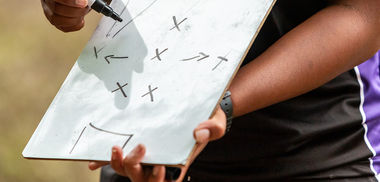

Are You Playing to Win or Not to Lose?
Warm Up
“Avoiding danger is no safer in the long run than outright exposure. The fearful are caught as often as the bold." –Helen Keller
We know the value of training our bodies so that we are physically capable of accomplishing what we want to in competition. But just as important, if not more so, is the mindset we enter in with and seek to maintain.
Workout
When you compete, do you play to win or not to lose? When playing to win, you are living out of your true identity, able to completely be yourself. You are operating in what’s called the “joy center,” which is located in the right brain.
Think about a time when you have been truly on top of your game. What was the dominant emotion? When we’re performing in joy, we allow ourselves to be fully present—things seem to take less effort. You take mistakes in stride, learn and move on with more determination. There is joy in doing what you were created to do.
It makes me think of that great line in Chariots of Fire…
“I believe God made me for a purpose, but he also made me fast. And when I run I feel His pleasure.” – Eric Liddell
Where is your joy level? Do you feel God’s pleasure when you are doing what you do best?
When you’re playing not to lose, the dominating emotion here is one of fear, which resides in the left brain. At the core, you feel that who you are or what you bring isn’t enough. This mindset thinks that by creating worry or fear, we are being more careful and calculated. In truth, the exact opposite is true. We are creating a “threat” environment which negatively affects our performance.
How often have you seen a team that is leading drop back into a “safe” posture to protect that lead? Momentum shifts and the lead is often lost to the team that attacks and focuses on winning.
Let’s take a basketball player at the foul line who is in the "playing not to lose" mode. Their thought process might go something like this: “Don’t miss. You better get it right. Don’t make a fool of yourself. Don’t mess up and let the team down.” This shooter will probably miss more shots than he or she makes versus the player shooting to win.
The player shooting to win thinks, “I can’t imagine not hitting it. I will be successful. I’ve got this no problem.”
Our brains are wired to keep us safe, to keep us comfortable, so they will keep us in the status quo and guard us against what we don't want to happen. If left unchecked, it is driven by what scares you—on what you don't want. What often results is exactly what you don’t want and over time, this sucks the joy out of your sport.
“When you are playing to win your energy is channeled into creating new opportunities, breaking new ground, and going after what you want to make happen. It requires putting what you already have at risk for the sake of something bigger, something better. It's about trading the safety of the known for the uncertainty of a future that is yet to be created. It takes courage because it involves risk.” –Margie Warrell
Be a risk taker. Play to win. Take time to reflect on how you are approaching competition, your challenges, and your life in general. It is vital as an athlete that you are aware of the mindset you bring to your field of competition every day. It has a profound impact on the outcome!
Cooldown
Can you recall a time when you played with great joy? What did that feel like? What was the outcome?
What takes you out of playing with joy (when your motivation is fear)? What does that feel like? What was the outcome?
Assess where you’re at right now. Are you playing to win or not to lose?
If it’s the latter, what’s a step you can take to start changing your mindset?
Tips for playing to win:
Keep your competitive edge – play with confidence, energy, be aggressive and give 100% from start to finish
Take calculated risks – stick with the game plan but be flexible when opportunities arise
Keep attacking – my coaches often said good defense creates good offense. Keep defending to thwart opponent’s progress but resist the temptation to play it safe when you have the lead
Own your mistakes – own it when you make a mistake. Learn, make adjustments and move on. Don’t play the ‘blame game’
Take advantage of opportunities – again, don’t play it safe when you have a lead. When you see holes in your opponent’s strategy, use those to your advantage
To learn more about Amy’s one-on-one or group coaching for current athletes and athletes in transition, as well as her leadership training, go to [www.amysnowcoaching.com](www.amysnowcoaching.com).












